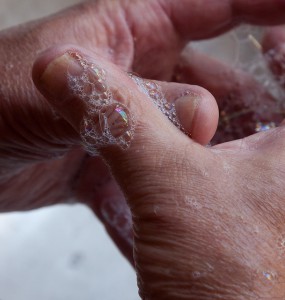Would you have believed that the percentage of people who wash their hands the right way is in the single digits? In a new study by Michigan State University, researchers found that only 5 percent of people who used a bathroom washed their hands long enough to stamp out infection-causing bacteria. This means that 95 percent of those studied did not wash their hands the right way.

Washing hands improperly contributes to 50 percent of all foodborne illness outbreaks.
It takes 15 to 20 seconds of vigorous hand-washing with soap and water to effectively kill the germs. So for how long do people actually wash their hands?
Six seconds. During the process, 33 percent didn’t use soap and 10 percent didn’t wash their hands at all.
The study, based on the observations of 3,749 people in public restrooms, appears in the Journal of Environmental Health. Hospitality professor Carl Borchgrevink and his colleagues trained college students to observe hand washing in restrooms in bars, restaurants, and other public establishments. The low hand washing rate was startling.
“These findings were surprising to us because past research suggested that proper hand washing is occurring at a much higher rate,” said Borchgrevink, associate professor of hospitality business and lead investigator on the study.
The findings are fascinating. Based on the study’s statistics, women are better with washing their hands; only 7 percent of women didn’t wash. In comparison, fifteen percent of men didn’t wash their hands. 78 percent of women used soap as opposed to 50 percent of men. People were more likely to wash their hands earlier in the day and less likely to wash their hands if the sink was dirty.
The good news is that people were more likely to wash their hands if a sign was present.
A reminder to wash hands compels people to practice good hygiene habits.
There are other tricks as well. Experts say that kids can sing one round of “Twinkle Twinkle Little Star” while washing to ensure that their hands are sufficiently bacteria-free. Stickers are also helpful reminders to wash your hands for just a bit longer.
Dr. Harley Rotbart, infectious disease expert and pediatrician, explained why hand washing is the best weapon to stave off spreading contagion.
“There are two germ-fighting approaches. Hand washing takes care of both of them. One of them is, as you said, killing the germs. There are anti-bacterial soaps that kill, they advertise, 99.9% of germs. The anti-biotic actually kills the germs,” said Dr. Rotbart. “Then there’s the physical act of manually removing the germs by the scrubbing, by your own actions of one hand rubbing against the other, in a thorough way under water with soap.”
Experts also recommend toting hand sanitizers, a very popular practice. Rotbart says, “My wife and I watch Jay Leno’s monologue some nights. He comes out and gives high fives to everybody who runs down from the audience. Then he puts his hands right in his pocket. We’re sure that he’s got hand sanitizer that he’s squirting on his hands in his pockets. Then he takes his hands out of his pockets and he rubs his hands like this before he begins his monologue. It’s to protect himself; we’re sure, from the multiple hands that he’s just come in contact with.”
Jay Leno is widely rumored to have hand sanitizers sewn in his pockets.